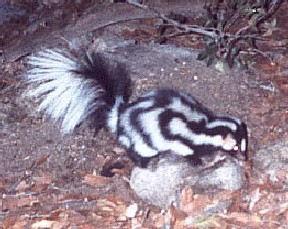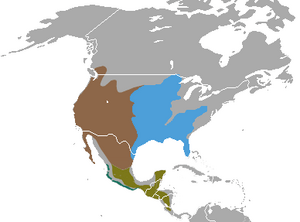Spotted skunk facts for kids
Quick facts for kids Spotted skunk |
|
|---|---|
 |
|
| Western spotted skunk (Spilogale gracilis) | |
| Scientific classification |
|
| Kingdom: | Animalia |
| Phylum: | Chordata |
| Class: | Mammalia |
| Order: | Carnivora |
| Family: | Mephitidae |
| Genus: | Spilogale Gray, 1865 |
 |
|
| Spotted skunk ranges Spilogale angustifrons Howell, 1902
|
|
Spotted skunks are small, furry animals known for their unique black and white patterns. They belong to a group of skunks called Spilogale. There are four main types, or species, of spotted skunks alive today: the Western spotted skunk, Eastern spotted skunk, Pygmy spotted skunk, and Southern spotted skunk.
These skunks are famous for their special way of defending themselves. When they feel threatened, they can spray a very strong, unpleasant smell. This helps keep predators away.
Contents
Types of Spotted Skunks
There are four main types of spotted skunks that live today. Each type has its own scientific name and lives in different parts of the world.
| Image | Scientific Name | Common Name | Where They Live |
|---|---|---|---|
| Spilogale gracilis Merriam, 1890 |
Western spotted skunk | Western United States, northern Mexico, and southwestern British Columbia | |
| Spilogale putorius (Linnaeus, 1758) |
Eastern spotted skunk | Central and southeastern United States, parts of Canada and Mexico | |
| Spilogale pygmaea Thomas, 1898 |
Pygmy spotted skunk | Pacific coast of Mexico | |
| Spilogale angustifrons Howell, 1902 | Southern spotted skunk | Mexico, Guatemala, Honduras, El Salvador, Nicaragua, Costa Rica and Belize |
About Spotted Skunks
The name Spilogale comes from two Greek words. Spilo means "spotted," and gale means "weasel." So, it literally means "spotted weasel."
The word Putorius is Latin for "fetid odor," which means a very strong, bad smell. Gracilis is Latin for "slender," describing their body shape.
Sometimes, the Eastern spotted skunk was called by other names. These included civet cat, polecat, or little spotted skunk.
Where They Live
Range
The Western spotted skunk (Spilogale gracilis) lives in the western parts of North America. You can find them from southern British Columbia in Canada, all the way down to Central America. They also live in some states like Montana, Wyoming, and Colorado.
The Eastern spotted skunk (Spilogale putorius) lives in the central and southeastern United States. They are also found in small areas of Canada and northeastern Mexico. In some areas, like the Great Plains, their numbers have grown. This might be because there is more farming, which means more mice for them to eat.
Habitat
Spotted skunks usually like to live in places with lots of cover. This includes thick bushes, woods, and areas near streams. The Eastern spotted skunk especially likes rocky and woody places with plenty of plants.
These clever animals prefer to live in dens or natural hollows. They might use old tree stumps or hollow logs. They often choose dens that are completely dark inside.
Spotted skunks are good at digging, but they often use dens made by other animals. They might move into homes dug by gophers, wood rats, or even other types of skunks. They are quite social and sometimes share a den with up to seven other skunks. However, mother skunks raising babies usually keep their dens private.
Biology
Reproduction
Spotted skunks usually start mating in March. Male skunks' bodies get ready for mating around this time. Female skunks also become ready to have babies.
For Western spotted skunks, mating often happens in late September and early October. After mating, the tiny embryos can stay in the mother's body for about 6.5 months before they start growing quickly.
Once they start growing, it takes about 30 days for the babies to develop. The baby skunks are usually born between April and June. A mother skunk typically has about five or six babies at a time.
Growth
Newborn skunks are born with soft fur that already shows their black and white patterns. Their eyes open when they are about 30 to 32 days old.
The young skunks start eating solid food when they are about 42 days old. They stop drinking their mother's milk at about two months old. They reach their full adult size when they are about four months old. Male skunks do not help raise the young.
Defenses
Spotted skunks protect themselves by spraying a strong, bad-smelling liquid. They have two special glands near their tail that hold this oil. When a skunk feels threatened, it turns its body into a U-shape. This way, both its head and its tail are facing the attacker.
Muscles around the glands help the skunk aim its spray very accurately. They can hit targets up to 15 feet away! Before spraying, a skunk will give a warning. It might stamp its front feet, raise its tail, and make a hissing sound. They also do a unique "handstand" with their back legs in the air and their tail waving. This is a clear sign to back off!
The skunk's spray is made of special chemicals called thiols. These are the main reason for the strong odor. Skunks can store about one tablespoon of this oil. They can spray up to five times in a row before needing to refill. It takes about one week for their body to make more oil.
Getting Rid of the Smell
If a person or pet gets sprayed by a skunk, you can remove the smell. You can change the smelly chemicals into ones that don't smell bad. This is done by mixing hydrogen peroxide and baking soda. This mixture is gentle enough for people and animals. However, it might change hair color.
Stronger cleaners, like liquid laundry bleach, can be used for other materials. They are good for cleaning things that have been sprayed.
Diet
Spotted skunks are omnivores, which means they eat both plants and animals. Their diet includes small rodents, fruits, berries, birds, eggs, and insects. They also eat larvae, lizards, snakes, and dead animals (carrion).
What they eat can change depending on the season. This is because different foods are available at different times of the year. Skunks have a very good sense of smell, which helps them find food like grubs. They also have excellent hearing, but their eyesight is not very good.
Life Expectancy
In zoos or other protected places, spotted skunks can live for up to 10 years. However, in the wild, their lives are much shorter. About half of all wild skunks die after only one or two years.
Conservation
The Eastern spotted skunk (S. putorius) is a species that needs our help. Their numbers seemed to drop a lot in the 1940s. Because of this, many states now list them as endangered, threatened, or a species "of concern." We need more information about them to help protect them.
The Pygmy spotted skunk (S. pygmaea) lives only on the Pacific coast of Mexico. This species is also threatened. The forests where they live are also in danger. The Pygmy spotted skunk is one of the smallest meat-eating animals in the world.
See also
 In Spanish: Mofetas moteadas para niños
In Spanish: Mofetas moteadas para niños




